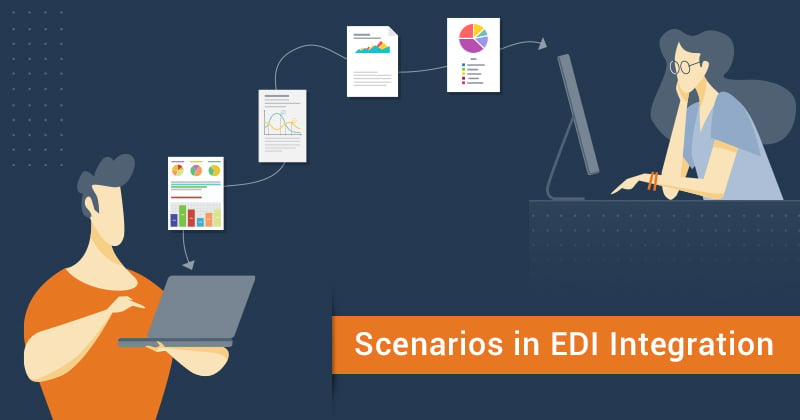EDI Integration with ERP: What Are Your Choices? (Explained with Scenarios)
 James Smith
James Smith
Table of contents
Did you know that Electronic Data Interchange (EDI) improves data quality and reduces errors in transactions (caused by illegible handwriting, lost faxes/email, and data entry errors) by at least 30%-40%? Yet, over 41% of companies have no EDI capabilities. So, where are you in your EDI implementation journey?
Are you just getting started or considering expanding your existing EDI, and do you need to make fundamental choices on integrating this with your ERP (Dynamics 365 F&SCM)? At STAEDEAN, we speak to many customers and prospects to help them with EDI implementation and integration. And we understand that this process of making the right choice in EDI integration can be daunting if you do not have a comprehensive understanding of the various business scenarios that you can select.
Here’s an attempt to give you some helpful information on the choices available to you in EDI implementation.
What is EDI integration? Why is it essential?
EDI refers to an automated process for exchanging business documents (purchase orders, invoices, shipping statuses, inventory documents to name a few examples) between business partners, also called trading partners. EDI transmission follows a structured format, completed over a secure, standardized connection (protocol). And the process of setting up a complete EDI workflow between trading partners is referred to as EDI integration.
It would be right to say that implementing EDI is all about digital transformation and integrating the supply chain. Here are some of the many benefits EDI integration offers:
- It automates business processes between customers, suppliers, and third-party logistic service providers (3PL) in the supply chain, irrespective of their geographical location.
- It helps improve employee efficiency, meet customer demands, and streamline service delivery and goods.
Let’s take a deep dive into the possible scenarios in setting up and integrating EDI so that you can weigh up your options and make the right choices.
Business scenarios in EDI integration
Let’s consider an example where Company A has a manufacturing unit in Europe and has a logistics service provider in the USA to deliver its products across the USA. Company A has very few trading partners with EDI, and there is a massive volume of documents exchanged between Company A and its logistics service provider.
What are the choices available to Company A in EDI integration?
Scenario 1: Direct EDI Integration
Direct EDI integration refers to a direct connection over the internet between your ERP system and trading partners using a specific protocol, establishing a secure communication line to exchange electronic documents (also referred to as messages). Both you and your trading partner need to use the same communication method or protocol.
When you exchange a high volume of documents with your trading partners, it makes sense to opt for direct EDI integration. It is the most basic choice and works well for starters, although when you need to set it up for many trading partners, its implementation is time-consuming and requires a lot of knowledge.

When you have a handful of trading partners with different systems and communication protocols, you need to make different integrations with each one of them from your ERP system. Although it’s a lot of work, direct EDI integration is possible with our EDI Studio and Data Integration Solution. It gives you full control of the EDI integration, and with some training you’ll be able to onboard new partners yourself.
Scenario 2: Indirect EDI Integration
Now, what if Company A wants to make EDI scalable by setting up a lot of EDI connections with other trading partners?
Direct EDI integration is not a scalable solution. That’s when you opt for indirect EDI integration.
Indirect EDI integration refers to the electronic exchange of documents/messages via a Value-Added Network (VAN) or a Managed Service EDI provider, also referred to as an EDI broker. An EDI broker offers your organization automated communication channels in multiple formats to communicate with different trading partners. Brokers also work with VANs to make connections with customers around the globe.

All you need to do is create a message with all the possible data fields you might use for any of the customers. This message is the ‘golden message’ or golden document. The broker takes care of picking the right fields as per the customer, does the translation/transformation to the right EDI format (both document format and protocol), and ensures it meets compliance standards. You might be aware that EDI standards vary across industries (X12, EDIFACT, Odette, VDA, Tradacoms are a few examples of EDI compliance standards), and there are specifics to these standards. It is difficult for an organization to maintain all that knowledge. But brokers are adept at adhering to different standards as they work with organizations from various industries.
So, if your organization is looking to scale up now or in the future, it is easier to set up a pipeline with these brokers who can take care of all the EDI integrations with your trading partners, leaving you with time to focus on your core workplace-related tasks. Of course, there is cost involved compared to a direct EDI integration, but it also offers greater scalability and more flexibility.
Two-Step Indirect EDI Integration
Referring to the previous example, if company A has multiple trading partners spread across the globe, and the broker does not have connections with all of them, what would be the next step?
In this case, the two-step indirect EDI integration, which is a slight variation of indirect EDI integration would be the ideal choice. Here, a broker ties up with VANs for successful EDI integration with global trading partners.

Scenario 3: Hybrid EDI Integration
Let’s consider an example where company A exchanges large volumes of documents with trading partners Y and Z. It also has many other trading partners where the transfer of documents is in a lesser volume as compared to Y and Z.
What would be the right option for EDI integration in this case?
It seems like you need a mix of direct and indirect EDI integration. And that’s what we refer to as Hybrid EDI integration.
In Hybrid EDI integration, the exchange of electronic documents happens both directly and indirectly.

If you’re wondering why you can’t just opt for indirect EDI integration in this case, here’s why. When you have a lot of data (any data, not necessarily EDI documents) going back and forth between trading partners, it is best to go for direct EDI integration. Another reason could be that the trading partner can handle the golden message/document themselves. After all, it doesn’t make sense to have millions of transactions go via a broker as it would mean additional expenditure.
You can leverage indirect EDI integration when the volume of messages is less, and there are different standards and protocols to follow. In short, hybrid EDI offers the option to choose based on the volume, frequency, and complexity of transactions.
| Tip: Hybrid EDI integration requires flexibility in the integration process. It would help to have the right technical infrastructure and knowledge. |
For strategic businesses who want to be more in control of the EDI process, STAEDEAN can help set up both direct and indirect EDI connections.
Scenario 4: EDI Integration 2.0; Connect customers without EDI!
While many of your large trading partners may be using EDI, some businesses (large and mid-scale) with whom you still exchange a lot of documents may not. (because of the cost involved or technical inabilities).
So how do you onboard customers or suppliers who are not able to do EDI messaging?
I like to call this scenario EDI 2.0 because we are adding another level to EDI communications, it is different from a standard EDI integration that you would typically do.
Here’s an example to explain this. Let’s say you have customers or suppliers who can generate an Excel document for an order or a PDF for an invoice, which they can send by email. The trading partner sends the document to the broker, who transforms and translates the message into the same integration to D365 like the one in place for normal EDI messaging. There are brokers who are specialized in onboarding such Non-EDI customers or vendors.
Dynamics 365 F&SCM users will not notice any difference and be able to handle all documents in the same way, this is what I call real digital transformation.

Some EDI brokers also offer functionality such as web portals which are branded the same as the branding followed by the company using D365 F&SCM. They can let customers add their orders to this portal and integrate it with Dynamics 365 via the same integration. As you can see, there can be a lot of added value from a broker in handling all the different standards and connecting customers or vendors with non-EDI means.
The Right Way Forward
To stay competitive in an ever-changing digital world, organizations must continue investing in B2B infrastructure. And for companies looking at quick business process integration and increased business agility, EDI is an essential toolset.
At STAEDEAN, we offer an embedded, no-code EDI-handling solution — EDI Studio — for Microsoft Dynamics 365 Finance & Supply Chain Management. This integrated EDI solution can help you implement EDI in D365 and onboard trading partners rapidly without any need for development. Trusted by over 2,200 industry leaders, we can help you succeed as a competitive company that provides the highest value to its trading partners.
Are you looking for more guidance on making the right choice in EDI integration? Reach out to us NOW! And if you are looking to streamline your supply chain processes with EDI for Dynamics 365, don't forget to download this eBook.

